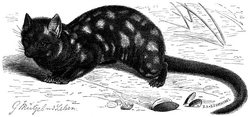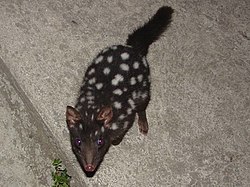Difference between revisions of "AY Honors/Marsupials/Answer Key"
(iw) |
(int) |
||
| Line 1: | Line 1: | ||
| − | {{Taxobox | + | {{Taxobox | color = pink |
| − | | color = pink | + | | image = Dasyurus_viverrinus.jpg |
| − | | | + | | image_width = 220px |
| − | | status = | + | | image_caption = Eastern Quoll |
| + | | name = Eastern Quoll | ||
| + | | status = LR/nt | ||
| trend = down | | trend = down | ||
| − | + | | regnum = [[Animalia]] | |
| − | + | | phylum = [[Chordata]] | |
| − | + | | classis = [[Mammalia]] | |
| − | | regnum = [[ | + | | ordo = [[Dasyuromorphia]] |
| − | | phylum = [[ | + | | familia = [[Dasyuridae]] |
| − | | classis = [[ | + | | genus = ''[[Dasyurus]]'' |
| − | + | | species = '''''D. viverrinus''''' | |
| − | | ordo = [[ | + | | binomial = ''Dasyurus viverrinus'' |
| − | | familia = [[ | + | | binomial_authority = ([[George Shaw|Shaw]], 1800) |
| − | |||
| − | | genus = '' | ||
| − | |||
| − | | species = ''''' | ||
| − | | binomial = '' | ||
| − | | binomial_authority = ([[ | ||
}} | }} | ||
| − | + | The '''Eastern Quoll''', ''Dasyurus viverrinus'', is a medium-sized [[carnivorous]] [[dasyurid]] [[marsupial]] native to [[Australia]]. They are now considered extinct on the mainland, but remain widespread and even locally common in [[Tasmania]]. It is one of six extant species of [[quoll]]. | |
| − | The ''' | ||
| − | + | == Description == | |
| + | [[Image:Tüpfelbeutelmarder brehm.png|thumb|left|220px|Illustration of an Eastern Quoll by [[Brehms Tierleben]].]] | ||
| + | The Eastern Quoll is generally about the size of a small [[domestic cat]], with an adult male averaging 60cm and weighing approximately 1.3kg. Their thick coat is covered by white spots, and ranges in colour from a light fawn to a near black, with an off-white belly. They can be distinguished from the [[Tiger Quoll]] by their slender build, pointed snout and lack of spots on the tail. | ||
| − | The | + | == Behaviour == |
| + | The Eastern Quoll is a solitary predator, hunting at night for its prey of insects and small mammals. They have also been known to scavenge food from the much larger [[Tasmanian Devil]]. | ||
| − | The | + | The breeding season begins in early winter, and the female gives birth to up to 30 young. Of these, the first to attach themselves to the six teats will be the only survivors. Weaning takes place at about 10 weeks of age, with the young staying in the den whilst the mother forages. |
| − | + | == Threats == | |
| + | [[Image:Eastern Quoll (Black).JPG|thumb|right|220px|A black eastern quoll photographed in Tasmania.]] | ||
| + | The main threats to the Eastern Quoll are competition and predation from feral cats and illegal poisoning and trapping. The lack of [[fox]]es and [[dingo]]es in Tasmania is believed to have contributed to the survival of the species. | ||
| − | + | == References == | |
| + | * {{IUCN2006|assessors=Australasian Marsupial & Monotreme Specialist Group|year=1996|id=6296|title=Dasyurus viverrinus|downloaded=11 May 2006}} | ||
| + | *{{MSW3 Groves|pages=25}} | ||
| − | == | + | == External links == |
| − | + | *[http://warrawong.com/meet_the_animals.html Eastern Quolls at Warrawong Sanctuary, the largest captive breeding program in mainland Australia.] | |
| − | |||
| − | |||
| − | |||
| − | |||
[[Category:Mammals of Australia]] | [[Category:Mammals of Australia]] | ||
| − | [[Category: | + | [[Category:Dasyuromorphs]] |
| − | [[cs: | + | [[cs:Kunovec tečkovaný]] |
| − | [[de: | + | [[de:Tüpfelbeutelmarder]] |
| − | [[ | + | [[es:Dasyurus viverrinus]] |
| − | [[ | + | [[lt:Viverinė sterbliakiaunė]] |
| − | |||
| − | |||
| − | |||
| − | |||
Revision as of 16:48, 21 January 2007
Template:Taxobox The Eastern Quoll, Dasyurus viverrinus, is a medium-sized carnivorous dasyurid marsupial native to Australia. They are now considered extinct on the mainland, but remain widespread and even locally common in Tasmania. It is one of six extant species of quoll.
Description

The Eastern Quoll is generally about the size of a small domestic cat, with an adult male averaging 60cm and weighing approximately 1.3kg. Their thick coat is covered by white spots, and ranges in colour from a light fawn to a near black, with an off-white belly. They can be distinguished from the Tiger Quoll by their slender build, pointed snout and lack of spots on the tail.
Behaviour
The Eastern Quoll is a solitary predator, hunting at night for its prey of insects and small mammals. They have also been known to scavenge food from the much larger Tasmanian Devil.
The breeding season begins in early winter, and the female gives birth to up to 30 young. Of these, the first to attach themselves to the six teats will be the only survivors. Weaning takes place at about 10 weeks of age, with the young staying in the den whilst the mother forages.
Threats
The main threats to the Eastern Quoll are competition and predation from feral cats and illegal poisoning and trapping. The lack of foxes and dingoes in Tasmania is believed to have contributed to the survival of the species.
References
External links
cs:Kunovec tečkovaný de:Tüpfelbeutelmarder es:Dasyurus viverrinus lt:Viverinė sterbliakiaunė

